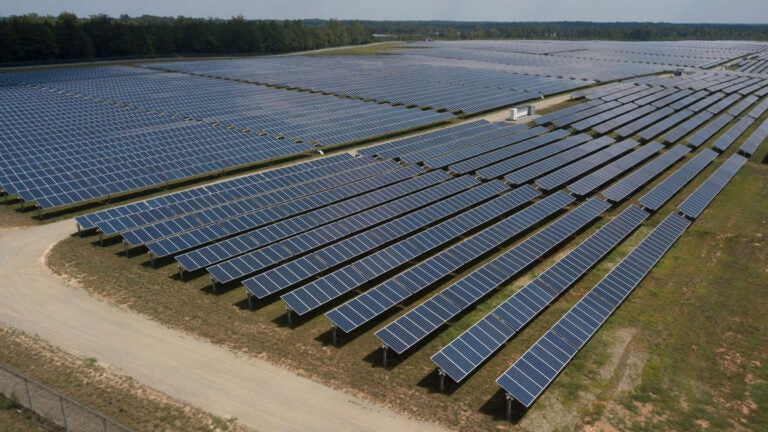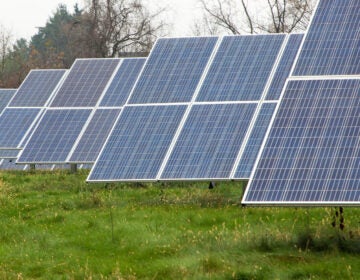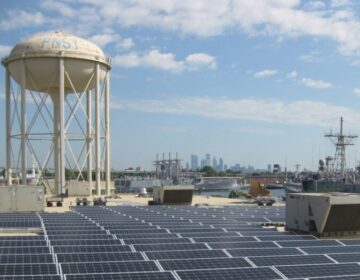Big-time boost for solar energy in N.J. could cost utility customers big-time
A $1.4B annual price tag by 2030 "might be cheaper than what we’re doing now," says one longtime critic of state subsidies to solar developers.

(AP Photo/Steve Helber)
This story originally appeared on NJ Spotlight.
___
By 2030, the state’s goal to ramp up its reliance on solar energy to power New Jersey homes and businesses could cost utility customers roughly $1.4 billion a year, according to a new draft report.
The consultant report for the New Jersey Board of Public Utilities offers a framework for how the state will help achieve the Murphy administration’s goal of transitioning to 100% clean energy by mid-century. By 2050, at least 34% of the state’s electricity will be produced by solar panels, according to the administration.
But it will come at a cost. The draft report provides preliminary findings of what kinds of financial incentives are needed to support robust solar development in New Jersey, yet at the same time lowering costs to the state’s 4 million ratepayers, according to BPU. By 2021, those costs are projected to rise to $800 million annually, and $1.4 billion by 2030, according to the report.
Two years ago this spring, Gov. Phil Murphy signed a bill that aimed, among other things, to rein in the costs of New Jersey’s successful — but expensive — solar program, which critics argued saddled utility customers with paying too-lucrative subsidies to promote growth of solar in the state. The state has roughly 129,000 solar installations.
As a result, the state decided to scrap its 16-year-old market-based system to finance solar projects. Instead, the report suggests establishing a hybrid program that uses a competitive solicitation approach for grid-scale solar projects and a fixed incentive for smaller projects — similar to a system now in place for the state’s transition program until a permanent system is adopted sometime next year.
Expect a vigorous debate
The preliminary findings mark the first step of what is expected to be a vigorous debate among various stakeholders, including solar developers, clean-energy backers, and consumer advocates. By and large, solar developers and others seem to consider the recommendations a good first step to developing a new program, although most cautioned their views depended on the accuracy of modeling and assumptions made by the consultant, Cadmus Group, LLC.
“I’m confident that the rigorous approach we’ve applied, and will continue to apply throughout the process, will provide the best possible outcome for a healthy and vibrant industry to those in the business community while ensuring its affordability for New Jersey consumers,’’ said BPU President Joseph Fiordaliso.
Whether it will succeed in the affordability goal remains to be seen. “It is not going to be low, but it might be cheaper than what we’re doing now,’’ said New Jersey Division of Rate Counsel Director Stefanie Brand, a longtime critic of the subsidies given to solar developers.
Spike in energy bills?
While noting the report is only preliminary, Brand questioned whether there was enough focus on how much it impacts ratepayers. “We really need to see the rate impact analysis of everything that we’re doing under the Energy Master Plan and show impacts on rates,’’ she said.
The state promised such an assessment during the process of adopting a new 2019 Energy Master Plan, but has yet to deliver on that promise. Consumer advocates and business groups fear it will lead to spikes in already-high energy bills for residents and businesses.
Brand has repeatedly asked why a long-promised analysis of what transitioning to offshore wind, solar, energy storage, and energy efficiency will cost ratepayers has yet to be forthcoming. “We’re in a historic economic crisis,’’ she said. “It’s never been more important to determine what we are going to ask people to pay.’’
Solar developers seemed to endorse certain aspects of the report’s recommendations, which included establishing fixed incentives to help solar projects be built.
“The big thing is certainty,’’ said Fred DeSanti, representing the New Jersey Solar Energy Coalition. “The more certainty there is, the easier it will be to line up financing for a project, and drive down costs.’’
Pushing for more incentives for residential projects
But DeSanti also pushed for the state to increase incentives for residential rooftop and ground-mounted solar projects, which had been reduced under the state’s transitional program. Those projects represent a significant portion of the work done by New Jersey’s 7,000-plus workforce in the sector.
“If these incentive issues can be successfully resolved in the successor program, we may well all be headed to a very bright future for our industry here in New Jersey,’’ he said.
It’s also key for the program to promote utility-scale solar projects by setting up a competitive solicitation among developers. Those projects are the most cost-effective solar facilities, a fact that aligns with the administration’s goal of achieving the least-cost strategy for clean energy.
WHYY is your source for fact-based, in-depth journalism and information. As a nonprofit organization, we rely on financial support from readers like you. Please give today.





